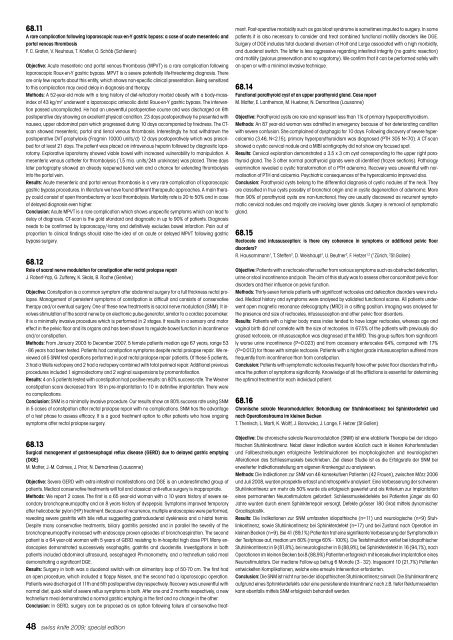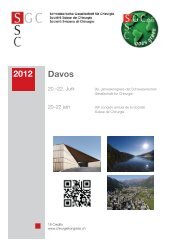Abstracts - Chirurgie Kongress
Abstracts - Chirurgie Kongress
Abstracts - Chirurgie Kongress
Create successful ePaper yourself
Turn your PDF publications into a flip-book with our unique Google optimized e-Paper software.
68.11<br />
A rare complication following laparoscopic roux-en-Y gastric bypass: a case of acute mesenteric and<br />
portal venous thrombosis<br />
F. C. Grafen, V. Neuhaus, T. Köstler, O. Schöb (Schlieren)<br />
Objective: Acute mesenteric and portal venous thrombosis (MPVT) is a rare complication following<br />
laparoscopic Roux-en-Y gastric bypass. MPVT is a severe potentially life-threatening diagnosis. There<br />
are only few reports about this entity, which shows non-specific clinical presentation. Being sensitized<br />
to this complication may avoid delay in diagnosis and therapy.<br />
Methods: A 52-year-old male with a long history of diet-refractory morbid obesity with a body-massindex<br />
of 43 kg/m 2 underwent a laparoscopic antecolic distal Roux-en-Y gastric bypass. The intervention<br />
passed uncomplicated. He had an uneventful postoperative course and was discharged on 6th<br />
postoperative day showing an excellent physical condition. 23 days postoperatively he presented with<br />
nausea, upper abdominal pain which progressed during 10 days accompanied by tiredness. The CTscan<br />
showed mesenteric, portal and lienal venous thrombosis. Interestingly he had withdrawn the<br />
postoperative DVT-prophylaxis (Fragmin 10000 units/d) 12 days postoperatively which was prescribed<br />
for at least 21 days. The patient was placed on intravenous heparin followed by diagnostic laparotomy.<br />
Explorative laparotomy showed viable bowel with increased vulnerability to manipulation. A<br />
mesenteric venous catheter for thrombolysis (1,5 mio. units/24h urokinase) was placed. Three days<br />
later portography showed an already reopened lienal vein and a chance for extending thrombolysis<br />
into the portal vein.<br />
Results: Acute mesenteric and portal venous thrombosis is a very rare complication of laparoscopic<br />
gastric bypass procedures. In literature we have found different therapeutic approaches. A main therapy<br />
could consist of open thrombectomy or local thrombolysis. Mortality rate is 20 to 50% and in case<br />
of delayed diagnosis even higher.<br />
Conclusion: Acute MPVT is a rare complication which shows unspecific symptoms which can lead to<br />
delay of diagnosis. CT-scan is the gold standard and diagnostic in up to 90% of patients. Diagnosis<br />
needs to be confirmed by laparoscopy/-tomy and definitively excludes bowel infarction. Pain out of<br />
proportion to clinical findings should raise the idea of an acute or delayed MPVT following gastric<br />
bypass surgery.<br />
68.12<br />
Role of sacral nerve modulation for constipation after rectal prolapse repair<br />
J. Robert-Yap, G. Zufferey, K. Skala, B. Roche (Genève)<br />
Objective: Constipation is a common symptom after abdominal surgery for a full thickness rectal prolapse.<br />
Management of persistent symptoms of constipation is difficult and consists of conservative<br />
therapy and/or eventual surgery. One of these new treatments is sacral nerve modulation (SNM). It involves<br />
stimulation of the sacral nerve by an electronic pulse generator, similar to a cardiac pacemaker.<br />
It is a minimally invasive procedure which is performed in 2 stages. It results in a sensory and motor<br />
effect in the pelvic floor and its organs and has been shown to regulate bowel function in incontinence<br />
and/or constipation.<br />
Methods: From January 2003 to December 2007, 5 female patients median age 67 years, range 53<br />
- 86 years had been tested. Patients had constipation symptoms despite rectal prolapse repair. We reviewed<br />
all 5 SNM test operations performed in post rectal prolapse repair patients. Of these 5 patients,<br />
3 had a Wells rectopexy and 2 had a rectopexy combined with total perineal repair. Additional previous<br />
procedures included 1 sigmoidectomy and 2 vaginal suspensions by promontofixation.<br />
Results: 4 on 5 patients tested with constipation had positive results: an 80% success rate. The Wexner<br />
constipation score decreased from 18 in pre-implantation to 10 in definitive implantation. There were<br />
no complications.<br />
Conclusion: SNM is a minimally invasive procedure. Our results show an 80% success rate using SNM<br />
in 5 cases of constipation after rectal prolapse repair with no complications. SNM has the advantage<br />
of a test phase to assess efficacy. It is a good treatment option to offer patients who have ongoing<br />
symptoms after rectal prolapse surgery.<br />
68.13<br />
Surgical management of gastroesophagal reflux disease (GERD) due to delayed gastric emptying<br />
(DGE)<br />
M. Matter, J.-M. Calmes, J. Prior, N. Demartines (Lausanne)<br />
Objective: Severe GERD with extra-intestinal manifestations and DGE is an underestimated group of<br />
patients. Medical conservative treatments will fail and classical anti-reflux surgery is inappropriate.<br />
Methods: We report 2 cases. The first is a 65 year-old woman with a 10 years history of severe secondary<br />
bronchopneumopathy and an 8 years history of dyspepsia. Symptoms improved temporary<br />
after helicobacter pylori (HP) treatment. Because of recurrence, multiple endoscopies were performed,<br />
revealing severe gastritis with bile reflux suggesting gastroduodenal dyskinesia and a hiatal hernia.<br />
Despite many conservative treatments, biliary gastritis persisted and in parallel the severity of the<br />
bronchopneumopathy increased with endoscopy proven episodes of bronchoaspiration. The second<br />
patient is a 64 year-old woman with 5 years of GERD resisting to in-hospital high dose PPI. Many endoscopies<br />
demonstrated successively esophagitis, gastritis and duodenitis. Investigations in both<br />
patients included abdominal ultrasound, oesophageal Ph-manometry, and a technetium solid meal<br />
demonstrating a significant DGE.<br />
Results: Surgery in both was a duodenal switch with an alimentary loop of 50-70 cm. The first had<br />
an open procedure, which included a floppy Nissen, and the second had a laparoscopic operation.<br />
Patients were discharged at 11th and 5th postoperative day respectively. Recovery was uneventful with<br />
normal diet, quick relief of severe reflux symptoms in both. After one and 2 months respectively, a new<br />
technetium meal demonstrated a normal gastric emptying in the first and no change in the other.<br />
Conclusion: In GERD, surgery can be proposed as an option following failure of conservative treat-<br />
48 swiss knife 2009; special edition<br />
ment. Post-operative morbidity such as gas bloat syndrome is sometimes imputed to surgery. In some<br />
patients it is also necessary to consider and treat combined functional motility disorders like DGE.<br />
Surgery of DGE includes total duodenal diversion of Holt and Large associated with a high morbidity,<br />
and duodenal switch. The latter is less aggressive regarding intestinal integrity (no gastric resection)<br />
and motility (pylorus preservation and no vagotomy). We confirm that it can be performed safely with<br />
an open or with a minimal invasive technique.<br />
68.14<br />
Functional parathyroid cyst of an upper parathyroid gland. Case report<br />
M. Matter, E. Lantheman, M. Huebner, N. Demartines (Lausanne)<br />
Objective: Parathyroid cysts are rare and represent less than 1% of primary hyperparathyroidism.<br />
Methods: An 87 year-old woman was admitted in emergency because of her deteriorating condition<br />
with severe confusion. She complained of dysphagia for 10 days. Following discovery of severe hypercalcemia<br />
(3.46, N



